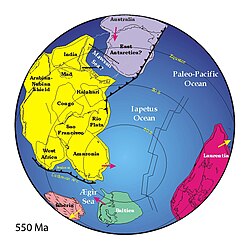Wikipedia:Wikiproject/Madagaskar/Werkplaats
Voor lange artikelen waaraan meer mensen kunnen werken kun je de werkplaats gebruiken. Elk nieuw artikel krijgt een onderkopje tussen twee is-gelijk-tekens (=zo dus=).
Geologie van Madagaskar[bewerken | brontekst bewerken]

De geologie van Madagaskar bestaat in het oosten en het centrale deel van het eiland voornamelijk uit diverse rotsen uit het Precambrium en stollingsgesteenten (basalt en Ryoliet) uit het Mesozoïcum en het Cenozoïcum. Het westelijke deel bestaat uit sedimentaire gesteenten uit de periode van het Carboon tot en met het Kwartair.
Het eiland is een microcontinent dat zich waarschijnlijk 88 miljoen jaar geleden van India heeft afgescheiden. In al die tijd is Madagaskar dichtbij de kust van Afrika gekomen, maar bleef altijd geïsoleerd.
Geschiedenis[bewerken | brontekst bewerken]

Volgens geleerden brak 135 miljoen jaar geleden een landmassa van het huidige Madagaskar, de Seychellen, Antarctica en India af van het supercontinent Gondwana.[1] Vervolgens brak ongeveer 88 miljoen jaar geleden Madagaskar af van India. In de daarop volgende periode naderde het eiland Madagaskar in het Mesozoïcum het gedeelte van het vasteland van Afrika dat nu Mozambique wordt genoemd, maar bleef altijd geïsoleerd. In deze periode zijn de meeste vulkanen op het eiland ontstaan. De zeestraat die Madagaskar van Afrika scheidt wordt tegenwoordig de Straat Mozambique genoemd.
Economie[bewerken | brontekst bewerken]

Madagaskar is een van de belangrijkste producenten van saffier[2] en grafiet. Ook wordt er chromiet, bauxiet en kolen gewonnen.[3]
Noten en referenties
Overige bronnen
|
Categorie:Paleogeografie Categorie:Geografie van Afrika
en:Gondwana Gondwana included most of the landmasses in today's Southern Hemisphere, including Antarctica, South America, Africa, Madagascar, and the Australian continent, as well as the Arabian Peninsula and the Indian Subcontinent, which have now moved entirely into the Northern Hemisphere.
Gondwana was formed from the following earlier continents and microcontinents, among others, colliding in the following orogenies:
- Azania: much of central Madagascar, the Horn of Africa and parts of Yemen and Arabia (Named by Collins and Pisarevsky (2005): "Azania" was a Greek name for the East African coast.)
- The Congo–Tanzania–Bangweulu Block of central Africa;
- Neoproterozoic India: India, the Antongil Block in far eastern Madagascar, the Seychelles, and the Napier and Rayner Complexes in East Antarctica
- The Australia/Mawson continent: Australia west of Adelaide and a large extension into East Antarctica
- Other blocks which helped to form Argentina and some surrounding regions, including a piece transferred from Laurentia when the west edge of Gondwana scraped against southeast Laurentia in the Ordovician.[1][2] This is the Famatinian block (named after Famatina in northwest Argentina) and it formerly continued the line of the Appalachians southwards.[3]

One of the major sites of Gondwanan amalgamation was the East African Orogeny (Stern, 1994), where these{{Which|date=May 2012}} two major orogenies are superimposed. The East African Orogeny at about 650–630 Mya affected a large part of Arabia, north-eastern Africa, East Africa, and Madagascar. Collins and Windley (2002) propose that in this orogeny, Azania collided with the Congo–Tanzania–Bangweulu Block.[4]
The later Malagasy orogeny at about 550–515 Mya affected Madagascar, eastern East Africa and southern India. In it, Neoproterozoic India collided with the already combined Azania and Congo–Tanzania–Bangweulu Block, suturing along the Mozambique Belt.[5]
Mesozoic[bewerken | brontekst bewerken]

Gondwana began to break up in the early Jurassic (about 184 Mya) accompanied by massive eruptions of basalt lava, as East Gondwana, comprising Antarctica, Madagascar, India, and Australia, began to separate from Africa. South America began to drift slowly westward from Africa as the South Atlantic Ocean opened, beginning about 130 Mya during the Early Cretaceous, and resulting in open marine conditions by 110 Mya. East Gondwana then began to separate about 120 Mya when India began to move northward.
The Madagascar block, and a narrow remnant microcontinent presently occupied by the Seychelles Islands, were broken off India; elements of this breakup nearly coincide with the Cretaceous–Paleogene extinction event. The India–Madagascar–Seychelles separations appear to coincide with the eruption of the Deccan basalts, whose eruption site may survive as the Réunion hotspot.
- ↑ The Assembly of Southern South America in the Late Proterozoic and Paleozoic: Some Paleomagnetic Clues|last= Rapalini|first= AE|year= 2001|conference= Spring Meeting 2001|publisher= American Geophysical Union|accessdate= 2010-01-18
- ↑ Rapalini, AE (1998). Syntectonic magnetization of the mid-Palaeozoic Sierra Grande Formation: further constraints on the tectonic evolution of Patagonia. Journal of the Geological Society 155 (1): pp. 105–114. DOI: 10.1144/gsjgs.155.1.0105.
- ↑ https://sp.lyellcollection.org/content/142/1/219.abstract Laurentia-Gondwana collision: the origin of the Famatinian-Appalachian Orogenic Belt (a review)
- ↑ Collins, Alan S, Windley, Brian F (May 2002). The Tectonic Evolution of Central and Northern Madagascar and Its Place in the Final Assembly of Gondwana. The Journal of Geology 110 (3): pp. 325–339. DOI: 10.1086/339535.
- ↑ Grantham, G.H., Maboko, M., Eglington, B.M. (2003). Proterozoic East Gondwana: supercontinent assembly and breakup. Geological Society, "A review of the evolution of the Mozambique Belt and implications for the amalgamation and dispersal of Rodinia and Gondwana", 417–418. ISBN 1-86239-125-4.
- ↑ H.M. Li and Z.K. Zhou (2007) Fossil nothofagaceous leaves from the Eocene of western Antarctica and their bearing on the origin, dispersal and systematics of Nothofagus. Science in China. 50(10): 1525-1535.
